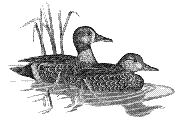United States Fish and Wildlife Service

Waterfowl Management Handbook
Date of this Version
January 1989
Abstract
Avian botulism is a paralytic, often fatal disease of birds resulting from ingestion of toxin produced by the bacterium Clostridium botulinum. Waterfowl die-offs from the botulism are usually caused by type C toxin; sporadic die-offs among fish-eating birds, such as common loons (Gavia immer) and gulls, have been caused by type E toxin.
Not enough is known about avian botulism to precisely identify the factors leading to an outbreak. When an outbreak does occur, it is usually perpetuated by a well-understood bird-maggot cycle (Figure 1).


Comments
Published in Diana H. Cross and Paul Vohs (eds.) Waterfowl Management Handbook. Fort Collins, CO: U.S. Fish and Wildlife Service, 1988. Online at http://www.nwrc.usgs.gov/wdb/pub/wmh/contents.html